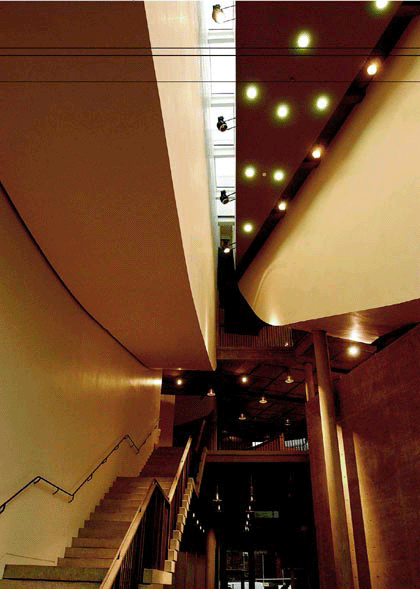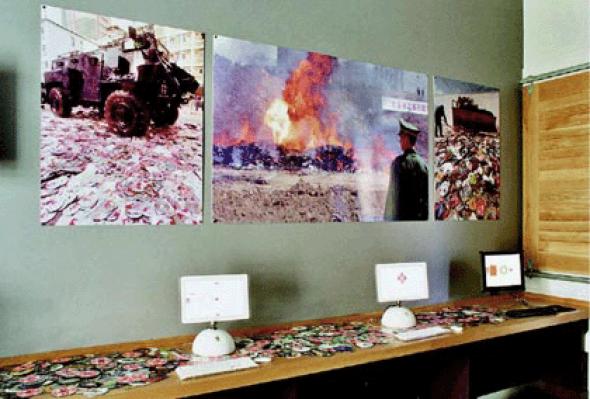The Facts of Life
After years of planning and construction, Liverpool’s new media centre FACT was finally launched in February. Here Matt Locke, one of FACT’s first visitors and an avid follower of its development over the years, expands upon his weblog Test.org to ask what FACT has in common with other organisations dealing with ‘emergent practices’. Is building audiences mutually exclusive with growing communities
FACT (Film, Art & Creative Technology) in Liverpool, has been one of the leading lights in commissioning digital arts for over 10 years now. It previously operated out of a small warren of offices in Bluecoat Chambers, Liverpool, with a broad portfolio of activities that has grown quite organically out of its core purpose: supporting media art. These include the regular Video Positive[1] festival, the ISEA 98 conference, The MITES[2] service for galleries wanting to show media art, and a fantastic collaboration programme[3] within the local community.
As the organisation grew, and FACT established an international reputation in its field, its infrastructural overheads remained relatively modest. Its offices were pretty basic and staff broadly aligned to specific projects, so it could expand or contract depending on the size of its commitments. It has had some hits[4] and misses[5], like any arts organisation, but has been around for over 10 years now, so this flexible, project-based approach seems to have worked.
But this has changed with the launch of the FACT Centre. In one fell swoop, the organisation has to understand how to manage a complex and expensive building, and will have to generate revenue for related staff costs, utilities, etc, before it can begin spending on artistic programmes. This shift has been the death knoll for many Lottery projects, but FACT has thought long and hard about this challenge. Clive Gillman[6], lead artist on the project, has presented many times over the last few years at conferences and working groups, and has always been refreshingly up-front about the realities of running a complex public building, and some of the hard compromises FACT’s staff have had to make.
But will they succeed? Will their ambition to support an existing commitment to cutting-edge media art sit happily alongside the wider audience turning up for the cinemas? In trying to move up and become a major public venue, FACT not only has to cope with managing a building, but also managing the responsibility for being a beacon project in the wider physical and cultural regeneration of Liverpool.
What this represents is a challenge of scale, and one that has echoes in the histories of other emergent practices. If we look at the way in which emergent media practices have been adopted into the cultural mainstream, scale, both architecturally and in terms of audience, has been a crucial factor. There is a repeating pattern of infrastructures that support emerging practices, and similar ideological crisis points between the practitioners and the infrastructures themselves. To be very crude, we could describe this pattern in four stages:
FIRST STAGE:Establishing a community of practitioners
As an new form of practice emerges, early practitioners seek each other out and establish shared vocabularies. Primary needs are access to production facilities, which are often expensive and hard to obtain, and a peer network to share ideas about political, cultural and technical issues. Audiences for the products of this community are usually limited to the community itself, with a focus on rapid innovation, rather than high-quality presentation or longevity. Good examples of historical infrastructures at this level include the many photography production and exhibition resources that developed in the 1970sand ‘80s, such as Impressions[7] in York or the now-defunct Camerawork in London. For net art, Rhizome[8] has played an essential infrastructural role, as did Backspace[9] and ARTEC in London.
SECOND STAGE:Establishing modes of display and developing audiences
After a production community has reached a critical mass, quality of presentation becomes a critical factor in establishing the value of cultural products. This is for a couple of reasons, including the need to address the criteria for public funding, and the maturing vocabulary of the emergent practice itself. First stage infrastructures often mutate to play a supporting role in this stage, developing more sophisticated physical or virtual spaces to showcase cultural products, and extending the network to peers on a national or global scale. Successful infrastructural organisations have an increasing effect on the emergent practice itself, by creating larger-scale opportunities that amplify certain elements of the practice whilst marginalising others. This is usually accompanied by the first crisis of identity amongst practitioners, with splits emerging between those who see this as ‘selling out’ and those who benefit from the opportunities. Most of the network of UK photography organisations went through this mutation in the 70s and 80s. Some managed to retain their links with practitioners, whilst others more overtly took the role of medium-sized galleries. Most significantly, the audience for these spaces grows outside of the practitioner networks, attracting ‘early-adopter’ members of the wider artistic community.
THIRD STAGE: Development of a ‘canon’ and historicisation of practices
The emergent practice is by now attracting a lot of interest from mainstream cultural infrastructures, including the media and museums. This accelerates the profile of the practitioners who successfully adapted with the mutating infrastructural organisations, and as a result appear as part of an early ‘canon’. This can be a problem, as the scale of opportunities increases rapidly, putting a strain on practitioners who don’t want to say no to the exposure, but can easily over-commit themselves and see the work suffer as a result. The inflationary pressures in this stage come from the ‘early adopter’ agents from the mainstream, who demand a level of quality and uniformity of practice that has not typically been there in the early stages. There is also a need to adapt the practice to the needs of their infrastructures – for example, a museum or a newspaper. Again, practitioners whose work can adapt to these needs prosper, whereas those who cannot, or choose not to because of their allegiance to the more political and egalitarian aims of the early stages of the emergent practice, find themselves increasingly marginalised. Audiences are now significant in size, and the mainstream exposure of the practice is no longer seen as such a novelty. A good example of this stage is the survey show, exemplified in digital art by the confluence of major shows at SFMOMA[10] and the Whitney[11] in 2001. Both these shows are typical in that they try to locate an emergent practice within a broader cultural milieu, attempting to trace historical precedents[12] and parallels with commercial practices.
FOURTH STAGE: Assimilation
By now, successful practitioners have been able to create international careers, and are regularly featured in mainstream shows along with more traditional practitioners, or are offered one-person shows in private galleries. This introduces a commercial audience for the work, and ways to edition[13] or otherwise commoditise[14] the practice are developed. The practice is now almost unrecognisable from its early, socialised forms, with any ambiguity about authorship, presentation orthodoxies and historical relationships resolved as part of its assimilation into the mainstream. Interestingly, there are virtually no examples of ‘emergent’ infrastructural organisations who can adapt to play a role at this level. Its a kind of glass ceiling – the shift in scale to meet the needs of audiences rather than communities is so huge that organisations face a crisis of identity, and many don’t survive. Those that do normally shift their focus to a related emerging practice that is at stage one, two or three, where they can more easily identify a role. This happened to most of the photography organisations in the UK, as emerging practices and funding streams for digital multimedia shifted support from ‘traditional’ chemical photography to these new forms.
 >> FACT interior photo by Paul McMullen
>> FACT interior photo by Paul McMullen
The challenge for FACT
In creating their new public identity, FACT are trying to break this glass ceiling. Rather than seeing emerging practices mutate to fulfill the needs of mainstream spaces, they are creating a bespoke centre that is at least partly based on the needs of emerging practices. It is intended to be a flexible, dynamic space - in a way a materialisation of the philosophy of the organisation over the past decade. But will they succeed?
That there are precious few precedents[15] is a worry, although there are a few similar projects that are in development.[16] They’ll need peers, both for the ‘network externalities’ this brings (sharing investment in programming, franchising exhibitions, etc) and for the kind of competition that will develop audience interest in this sector. The trouble is, the cost of making this shift in scale is so huge that there are unlikely to be many other organisations able to make the same step up, especially in a Lottery funding climate that is much harsher than when FACT got their funding. If they see their immediate peers as organisations out of their sector (the Tate, Whitechapel, etc), then the bespoke conditions of their space will not be exploited, as they’ll have to make concessions in their franchised programming to the facilities available in standard ‘white cube’ spaces. MITES is a partly successful attempt to deal with this, but is still geared towards adapting ‘white cubes’, not replicating the far more dynamic spaces that the FACT centre has.
But the biggest problem could be the building itself. All cultural centres of this scale subsidise their programming activity with the support services that mass audiences expect – cafes, bookshops, etc. FACT have addressed this head-on, with two cinema spaces that will show art-house programmes that are related to the other emergent work exhibited. But this could easily become the tail that wags the dog, as audiences might identify the FACT centre as a great cinema with some funky exhibition spaces attached.
Of course, this could be their overt intention. There is nothing wrong with that at all, but it would represent a significant shift away from the programming philosophies that have underpinned their work for over 10 years. This would also replicate the pattern sketched above – that no organisation involved in emergent networks of practitioners can manage the shift in scale from supporting communities to supporting audiences without fundamentally changing its ethos. Clay Shirky[17] has written extensively on the fundamental differences between communities and audiences, remarking that ‘Audiences are built, communities grow’. Emerging practices need the opportunity to be able to grow in scale and meet audiences on their own terms. Will the FACT Centre be the first successful attempt at creating an infrastructure for this, or will it have to embrace the audiences flooding through its doors, and leave artistic communities out on the street?
[1] Video Positive [http://www.fact.co.uk/vp/vp1.htm][2] MITES [http://www.mites.org.uk/index.htm][3] Collaboration programme [http://www.fact.co.uk/collab/collab1.htm][4] Hits [http://www.superchannel.org/Home/Info/Credits][5] Misses [http://amsterdam.nettime.org/Lists-Archives/nettime-l-9806/msg00027.html][6] Clive Gillman [http://www.mg.u-net.com/text.htm][7] Impressions [http://www.impressions-gallery.com/][8] Rhizome [http://www.rhizome.org][9] Backspace [http://bak.spc.org][10] SFMOMA [http://010101.sfmoma.org][11] Whitney [http://www.whitney.org/bitstreams][12] Historical precedents [http://on1.zkm.de/netCondition.root/netcondition/start/language/default_e][13] Edition[http://s1.amazon.com/exec/varzea/ts/exchangeglance/Y01Y4427168Y2611576/058-8989512-0351042][14] Commoditise [http://www.dot-store.com/][15] Precedents [http://on1.zkm.de/zkm/e/][16] Development [http://www.eyebeam.org/museum/index.html] See Adam Scrivener, Mute21[17] Clay Shirky [http://shirky.com/writings/broadcast_and_ community.html]
Matt Locke <matt AT test.org.uk> has worked as a curator and writer on media arts for the last 10 years. He publishes occasional writings on [http://www.test.org.uk], and is Head of Creative R&D for BBC New Media & Technology
Mute Books Orders
For Mute Books distribution contact Anagram Books
contact@anagrambooks.com
For online purchases visit anagrambooks.com








